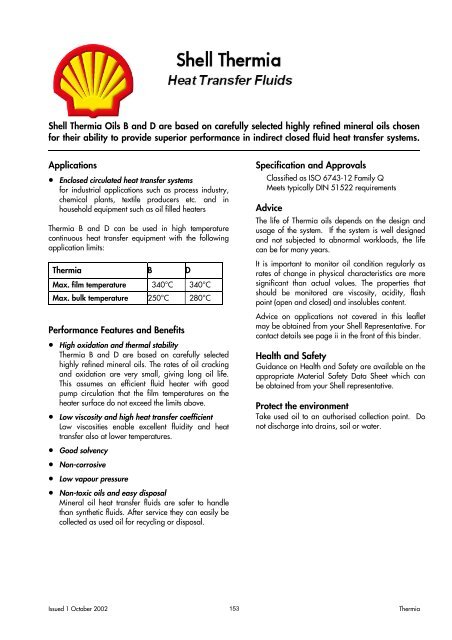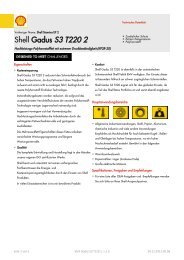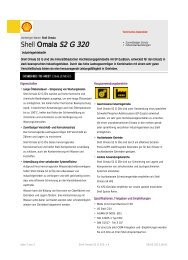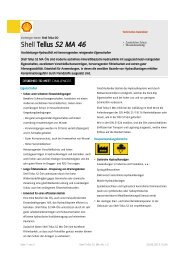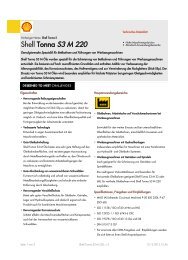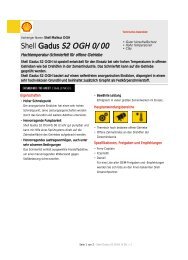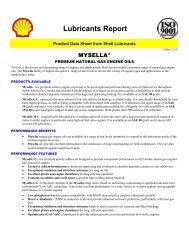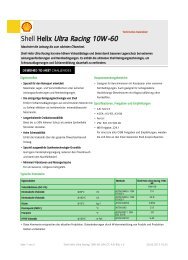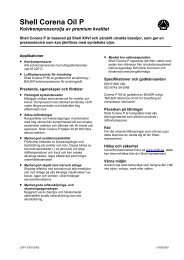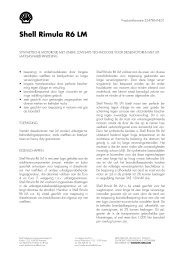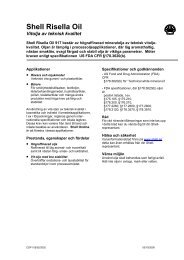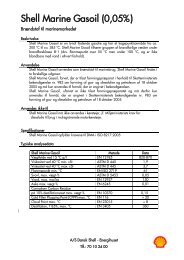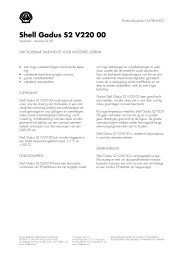Shell Thermia Oils B and D are based on carefully selected highly ...
Shell Thermia Oils B and D are based on carefully selected highly ...
Shell Thermia Oils B and D are based on carefully selected highly ...
Create successful ePaper yourself
Turn your PDF publications into a flip-book with our unique Google optimized e-Paper software.
<str<strong>on</strong>g>Shell</str<strong>on</strong>g> <str<strong>on</strong>g>Thermia</str<strong>on</strong>g> <str<strong>on</strong>g>Oils</str<strong>on</strong>g> B <str<strong>on</strong>g>and</str<strong>on</strong>g> D <str<strong>on</strong>g>are</str<strong>on</strong>g> <str<strong>on</strong>g>based</str<strong>on</strong>g> <strong>on</strong> c<str<strong>on</strong>g>are</str<strong>on</strong>g>fully <strong>selected</strong> <strong>highly</strong> refined mineral oils chosen<br />
for their ability to provide superior performance in indirect closed fluid heat transfer systems.<br />
Applicati<strong>on</strong>s<br />
• Enclosed circulated heat transfer systems<br />
for industrial applicati<strong>on</strong>s such as process industry,<br />
chemical plants, textile producers etc. <str<strong>on</strong>g>and</str<strong>on</strong>g> in<br />
household equipment such as oil filled heaters<br />
<str<strong>on</strong>g>Thermia</str<strong>on</strong>g> B <str<strong>on</strong>g>and</str<strong>on</strong>g> D can be used in high temperature<br />
c<strong>on</strong>tinuous heat transfer equipment with the following<br />
applicati<strong>on</strong> limits:<br />
<str<strong>on</strong>g>Thermia</str<strong>on</strong>g> B D<br />
Max. film temperature 340°C 340°C<br />
Max. bulk temperature 250°C 280°C<br />
Performance Features <str<strong>on</strong>g>and</str<strong>on</strong>g> Benefits<br />
• High oxidati<strong>on</strong> <str<strong>on</strong>g>and</str<strong>on</strong>g> thermal stability<br />
<str<strong>on</strong>g>Thermia</str<strong>on</strong>g> B <str<strong>on</strong>g>and</str<strong>on</strong>g> D <str<strong>on</strong>g>are</str<strong>on</strong>g> <str<strong>on</strong>g>based</str<strong>on</strong>g> <strong>on</strong> c<str<strong>on</strong>g>are</str<strong>on</strong>g>fully <strong>selected</strong><br />
<strong>highly</strong> refined mineral oils. The rates of oil cracking<br />
<str<strong>on</strong>g>and</str<strong>on</strong>g> oxidati<strong>on</strong> <str<strong>on</strong>g>are</str<strong>on</strong>g> very small, giving l<strong>on</strong>g oil life.<br />
This assumes an efficient fluid heater with good<br />
pump circulati<strong>on</strong> that the film temperatures <strong>on</strong> the<br />
heater surface do not exceed the limits above.<br />
• Low viscosity <str<strong>on</strong>g>and</str<strong>on</strong>g> high heat transfer coefficient<br />
Low viscosities enable excellent fluidity <str<strong>on</strong>g>and</str<strong>on</strong>g> heat<br />
transfer also at lower temperatures.<br />
• Good solvency<br />
• N<strong>on</strong>-corrosive<br />
• Low vapour pressure<br />
• N<strong>on</strong>-toxic oils <str<strong>on</strong>g>and</str<strong>on</strong>g> easy disposal<br />
Mineral oil heat transfer fluids <str<strong>on</strong>g>are</str<strong>on</strong>g> safer to h<str<strong>on</strong>g>and</str<strong>on</strong>g>le<br />
than synthetic fluids. After service they can easily be<br />
collected as used oil for recycling or disposal.<br />
Specificati<strong>on</strong> <str<strong>on</strong>g>and</str<strong>on</strong>g> Approvals<br />
Classified as ISO 6743-12 Family Q<br />
Meets typically DIN 51522 requirements<br />
Advice<br />
The life of <str<strong>on</strong>g>Thermia</str<strong>on</strong>g> oils depends <strong>on</strong> the design <str<strong>on</strong>g>and</str<strong>on</strong>g><br />
usage of the system. If the system is well designed<br />
<str<strong>on</strong>g>and</str<strong>on</strong>g> not subjected to abnormal workloads, the life<br />
can be for many years.<br />
It is important to m<strong>on</strong>itor oil c<strong>on</strong>diti<strong>on</strong> regularly as<br />
rates of change in physical characteristics <str<strong>on</strong>g>are</str<strong>on</strong>g> more<br />
significant than actual values. The properties that<br />
should be m<strong>on</strong>itored <str<strong>on</strong>g>are</str<strong>on</strong>g> viscosity, acidity, flash<br />
point (open <str<strong>on</strong>g>and</str<strong>on</strong>g> closed) <str<strong>on</strong>g>and</str<strong>on</strong>g> insolubles c<strong>on</strong>tent.<br />
Advice <strong>on</strong> applicati<strong>on</strong>s not covered in this leaflet<br />
may be obtained from your <str<strong>on</strong>g>Shell</str<strong>on</strong>g> Representative. For<br />
c<strong>on</strong>tact details see page ii in the fr<strong>on</strong>t of this binder.<br />
Health <str<strong>on</strong>g>and</str<strong>on</strong>g> Safety<br />
Guidance <strong>on</strong> Health <str<strong>on</strong>g>and</str<strong>on</strong>g> Safety <str<strong>on</strong>g>are</str<strong>on</strong>g> available <strong>on</strong> the<br />
appropriate Material Safety Data Sheet which can<br />
be obtained from your <str<strong>on</strong>g>Shell</str<strong>on</strong>g> representative.<br />
Protect the envir<strong>on</strong>ment<br />
Take used oil to an authorised collecti<strong>on</strong> point. Do<br />
not discharge into drains, soil or water.<br />
Issued 1 October 2002 153<br />
<str<strong>on</strong>g>Thermia</str<strong>on</strong>g>
Typical Physical Characteristics<br />
<str<strong>on</strong>g>Thermia</str<strong>on</strong>g> B D<br />
Density at 15 °C kg/l ISO 12185 0.868 0.881<br />
Flash Point PMCC °C ISO 2719 220 268<br />
Flash Point COC °C ISO 2592 230<br />
Fire Point COC °C ISO 2592 255<br />
Pour Point °C ISO 3016 -12 -6<br />
Kinematic Viscosity ISO 3104<br />
at 0 °C mm²/s 230<br />
at 40 °C mm²/s 25 108<br />
at 100 °C mm²/s 4.7 11.8<br />
at 200 °C mm²/s 1.2<br />
Initial Boiling Point °C ISO 3771 > 355<br />
Autoigniti<strong>on</strong> Temperature °C DIN 51794 360<br />
Neutralisati<strong>on</strong> Value mgKOH/g ASTM D974 < 0.05<br />
Water C<strong>on</strong>tent %m/m ISO 3733 < 0.1<br />
Ash (Oxid) %m/m ISO 6245 < 0.01<br />
Carb<strong>on</strong> Residue (C<strong>on</strong>rads<strong>on</strong>) %m/m ISO 10370 0.02<br />
Copper Corrosi<strong>on</strong> (3h/100°C) ISO 2160 class 1<br />
Coefficient of Thermal Expansi<strong>on</strong> 1/°C 0.0008<br />
These characteristics <str<strong>on</strong>g>are</str<strong>on</strong>g> typical of current producti<strong>on</strong>. Whilst future producti<strong>on</strong> will c<strong>on</strong>form to <str<strong>on</strong>g>Shell</str<strong>on</strong>g>'s specificati<strong>on</strong>,<br />
variati<strong>on</strong>s in these characteristics may occur.<br />
Typical Design Data<br />
<str<strong>on</strong>g>Thermia</str<strong>on</strong>g> B:<br />
Temperature °C 0 20 40 100 150 200 250 300 340<br />
Density kg/l 0.876 0.863 0.850 0.811 0.778 0.746 0.713 0.681 0.655<br />
Specific Heat Capacity kJ/kg*K 1.809 1.882 1.954 2.173 2.355 2.538 2.72 2.902 3.048<br />
Thermal C<strong>on</strong>ductivity W/m*K 0.136 0.134 0.133 0.128 0.125 0.121 0.118 0.114 0.111<br />
Pr<str<strong>on</strong>g>and</str<strong>on</strong>g>tl No. 3375 919 375 69 32 20 14 11 9<br />
Vapour Pressure mbar - - - - - 5 26 100 260<br />
<str<strong>on</strong>g>Thermia</str<strong>on</strong>g> D:<br />
Temperature °C 0 20 40 100 150 200 250 280<br />
Density kg/l 0.911 0.900 0.888 0.849 0.819 0.788 0.748 0.737<br />
Specific Heat Capacity kJ/kg*K 1.87 1.93 2.00 2.20 2.36 2.54 2.70 2.80<br />
Thermal C<strong>on</strong>ductivity W/m*K 0.130 0.128 0.1264 0.1217 0.1172 0.113 0.109 0.108<br />
Pr<str<strong>on</strong>g>and</str<strong>on</strong>g>tl No. - 6000 1000 165 59 33 22 9<br />
Issued 1 October 2002 154<br />
<str<strong>on</strong>g>Thermia</str<strong>on</strong>g>


